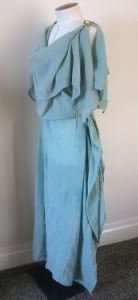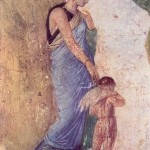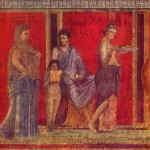Inspiration and Sources:
A 1st century CE palla and stola for a fashionable young Pompeiian matron, as seen in the Pompeiian art below.

The Dress Diary:
Fabric and Materials:
Mauve polished wool, and hand-dyed aqua wool gauze. Metal and shell button fibulae
Research:
- Stola
- Stola
- Pallium
- Fibula
- Gorsline, Douglas. What People Wore, Dover Publishing, New York, 1994. Pages 14-15
- Black, J Anderson and Garland, Madge. A History of Fashion, Orbis Publishing, London, 1975. Pages 60-69
Inspiration Art:






I’m making a Roman dress for a local competition. I really want it to be amazing, but I have no experience in this time period. (I’m Georgian through and through (-: ) Do you have any suggestions of websites where I could find inspiration and tips? You do amazing work!
Thanks,
S.
I have gotten confused by your terms. I looked up pallas and find it is the plural for pallu: the loose end of a sari. Stola I find is the sleeveless dress often sewed at the shoulders and worn only by married women over a tunica. What I do not understand is why you are showing a peplos dress. I love the draping of the wool gauze by the way. I realise the peplos could have been worn instead of the tunica, but then it would be worn under the stola. Try as I might I can not find a period source showing someone wearing a peplos instead of a tunica under a stola. So why did you call your garment a stola instead of a peplos?
the peplos was an ancient greek style of dress, while the similar-looking stola was roman. a palla (pallas is the modern plural, though it would have been pallae in latin) was a mantle that would have been draped over the stola and worn out of the house.